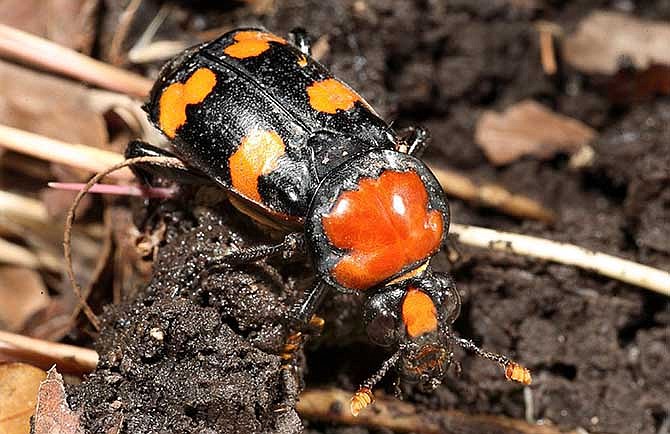ST. LOUIS (AP) - A colorful and once-thriving beetle is being reintroduced again in Missouri, part of an ongoing effort to boost the numbers of a bug known as one of nature's recyclers.
Since 2012, the St. Louis Zoo, the Nature Conservancy, the U.S. Fish and Wildlife Service and the Missouri Department of Conservation have collaborated to improve the population of American burying beetles at Wah'Kon-Tah Prairie in southwest Missouri. Toward that goal, the beetles are being bred at the zoo then periodically reintroduced at the prairie site.
Zoo officials said that 168 beetles were taken to Wah'Kon-Tah on June 3, and 180 more will be reintroduced Tuesday.
The beetles, like prairie chickens that have also been reintroduced at Wah'Kon-Tah, are important in returning the area to its natural state, said Todd Sampsell, Missouri state director for the Nature Conservancy.
"It's a component of an ecosystem that we've lost in these prairies in Missouri," Sampsell said.
The zoo-bred beetles are paired and marked by notching each beetle's elytra, or hard wing covers. Zoo officials say the process distinguishes captive-bred and wild beetles.
Officials reintroduced 236 beetles in the same area in 2012, and another 600 last June. The program marks the first effort to bring the beetles back to Missouri, the third state with a reintroduction program.
The beetle is up to an inch-and-a-half long, with a shiny black body and orange-red markings. It is nocturnal and spends most of its life underground. But strong flying skills and a keen sense of smell allow the beetles to track a carcass from two miles away.
Working in male/female pairs, the insects tunnel up to a foot deep in the ground (hence the "burying" part of the name). The female lays her eggs near the carcass of quail or other dead animals.
They remove fur or feathers from the body with pincers and emit an anti-bacterial secretion that slows decomposition, in essence embalming the body. Both parents feed their offspring by eating dead flesh and regurgitating it into the larvae's mouths.
Conservationists say that by recycling decomposing components back into the environment, the beetle plays a key role in the ecosystem.
The beetle was once found in 35 U.S. states and southern Canada. By 1989, only one population was known, in Rhode Island, and it became the first insect designated as a federally endangered species. Since then, additional populations have been found in six Midwestern states, though the only Missouri population is the one reintroduced at Wah'Kon-Tah.
Experts don't know what precipitated the beetle's decline, but scientists speculate it may have been due to pesticides, habitat loss and destruction, even competition by other scavengers of dead animals.
Bob Merz, manager for invertebrates at the St. Louis Zoo, said there is hope for the beetle in Missouri.
"The key is that we found offspring from beetles we introduced and that the offspring made it through the winter," Merz said. "This is especially promising given the harsh weather conditions of this past winter."

